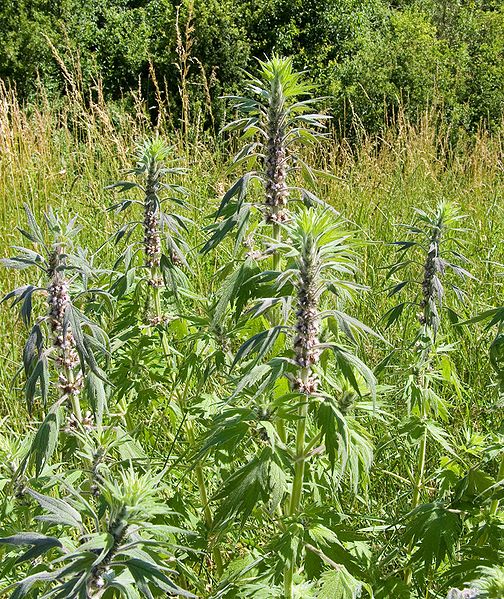(Leonurus cardiaca)
Other common names include Throw-wort, Lion's Ear, and Lion's Tail. The latter two are also common names for Leonotis leonurus. Motherwort (Leonurus cardiaca) is a herbaceous perennial plant in the mint family, Lamiaceae.
 |
| Motherwort leaves |
 |
| Motherwort plants The leaves have serrated margins and are palmately lobed with long petioles; basal leaves are wedge shaped with three points and while the upper leaves are more latticed. |
 |
| Motherwort at fields |
 |
| Motherwort flower L. cardiaca has a square stem and opposite leaves. |
 |
| Motherwort flower Flowers appear in leaf axils on the upper part of the plant |
Properties: nervine, tonic, antispasmodic, emmenagogue, diaphoretic and laxative.
What it affects: heart, nerves and uterus.
Preparation and amount:
Infusion: steep 5-15 min and drink 6 oz. 3-4 time a day.
Tincture: drink 30-60 drops (1/2-1 tsp) 4-4 times a day.
Fluid extract: drink 1/2-1 tsp 3-4 time a day.
Powder: drink 5-10 #0 capsules (30-60 grains) 3-4 times a day.
Purposes:
Internally, motherwort is most commonly used for nervous heart problem and for stomach gas and cramps. For this purpose, a good combination is equal parts of motherwort, cramp bark, and calendula. It relieves childbirth pain and is excellent for suppressed menstruation and other female problems, including amenorrhea. It is a good tonic for the heart and may be combined with hawthorn berries for an effective heart tonic and antispasmodic. This can be used to prevent heart attack and treat palpitations, pericarditis, and neuralgia. It is good for all nervous conditions, sleeplessness, convulsions, neuritis, neuralgia, and hysteria. It is used for shortness of breath, goiter, and congestion of respiratory passages. It is also used for menopausal symptoms and vaginitis. It is used for headache, thyroid, insomnia,vertigo, fever, rheumatism, and suppressed urine. In general, it has similar properties to valerian, and can be used like it.
Warning:
Contact with the plant mat cause dermatitis in some individuals.
Plant Description:
L. cardiaca leaves have serrated margins and are palmately lobed with long petioles; basal leaves are wedge shaped with three points and while the upper leaves are more latticed. It has a square stem and opposite leaves. The flowers are small, pink to lilac in color often with furry lower lips.Flowers appear in leaf axils on the upper part of the plant and it blooms between June - August. The plant grows to about 60–100 cm in height and it can be found along roadsides and in vacant fields and other disturbed areas.
No comments:
Post a Comment